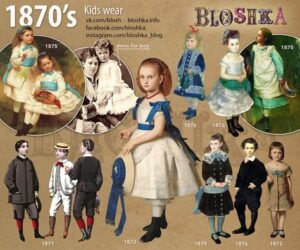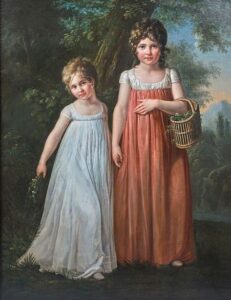Uncategorized
The History of Kids’ Fashion: From Classic to Contemporary
Kids’ fashion has undergone significant transformations over the centuries, evolving from miniature versions of adult clothing to a thriving industry with its own trends, styles, and innovations. Understanding the history of kids’ fashion reveals how cultural, societal, and economic shifts have influenced the way children are dressed.
This journey through time explores the evolution of kids’ fashion, from classic designs of the past to the contemporary styles we see today.
1. The Early Days: Miniature Adults (16th–18th Century)
In the early history of kids’ fashion, children were dressed as miniature versions of adults, reflecting societal views that childhood was merely a preparatory stage for adulthood.
- Key Features:
- Rich Fabrics: Upper-class children wore silk, velvet, and lace, mirroring the attire of their parents.
- Restrictive Designs: Boys wore breeches and waistcoats, while girls donned corsets and long skirts.
- Lack of Practicality: These outfits prioritized aesthetics over functionality, making them unsuitable for active play.
- Cultural Influence: The aristocracy set the trends, as clothing symbolized wealth and status. Children’s attire was meant to reflect the social standing of the family.
2. Enlightenment and the Rise of Practicality (18th Century)

The Enlightenment brought a shift in attitudes toward childhood, emphasizing its importance as a distinct stage of life. This change was reflected in kids’ fashion.
- New Trends:
- Comfort Over Style: Clothing became less restrictive, with simpler designs suited for movement and play.
- The Skeleton Suit: Boys began wearing one-piece suits with trousers and a jacket, marking a departure from adult styles.
- Empire Dresses: Girls wore lightweight dresses with high waistlines, inspired by classical Greco-Roman styles.
This era marked the beginning of children’s clothing being designed with their specific needs in mind.
3. The Victorian Era: Formality and Functionality (19th Century)
The Victorian period saw the emergence of a middle class and mass production, which influenced children’s fashion significantly.
- Key Features:
- Distinct Gender Roles: Boys and girls were dressed differently from an early age—boys in sailor suits and girls in frilly dresses.
- Layered Clothing: Multiple layers, including petticoats and stockings, were common.
- Practicality for Play: Play clothes, like smocks, became popular for middle-class children.
- Cultural Impact: Queen Victoria’s children often set trends, such as the popularity of tartan prints and lace collars.
4. The Roaring Twenties: Simplicity and Comfort (1920s–1930s)
The 20th century ushered in a more modern approach to kids’ fashion, influenced by changing social norms and economic factors.
- Key Trends:
- Drop-Waist Dresses: Girls’ dresses mirrored the flapper style, with simple silhouettes and shorter hemlines.
- Knickers and Overalls: Boys wore knickerbockers and suspenders for casual wear.
- School Uniforms: Standardized school uniforms became widespread during this period.
- Industrial Influence: Advances in textile production made children’s clothing more affordable and accessible.
5. Mid-Century Modern: Post-War Innovations (1940s–1950s)
After World War II, kids’ fashion became a distinct category, separate from adult trends.
- Key Features:
- Playwear Revolution: Clothing became more child-friendly, with practical fabrics like cotton and denim.
- Patterned Designs: Bright prints, polka dots, and checks added a playful touch.
- Iconic Styles: Boys wore button-up shirts and shorts, while girls embraced puffy skirts and Peter Pan collars.
- Cultural Influence: The rise of Hollywood introduced trends inspired by child stars like Shirley Temple.
6. The 1960s–1980s: Breaking Tradition and Embracing Trends
The counterculture movements of the 1960s and beyond influenced kids’ fashion to embrace individuality and creativity.
- 1960s:
- Bright, bold patterns and playful prints became popular.
- Gender-neutral designs began emerging, breaking down traditional norms.
- 1970s:
- Bell-bottoms and tie-dye shirts reflected the era’s free-spirited style.
- Tracksuits gained popularity as leisurewear for kids.
- 1980s:
- Neon colors, oversized silhouettes, and graphic tees defined the decade.
- The rise of branded clothing made logos a fashion statement for kids.
7. The Rise of Kids’ Fashion as a Market (1990s–2000s)
By the 1990s, kids’ fashion became a booming industry with dedicated brands and lines.
- Key Features:
- Comfortable Casualwear: Denim jeans, sneakers, and sweatshirts dominated everyday fashion.
- Pop Culture Influence: Cartoon characters, movie franchises, and celebrities drove trends.
- Mini-Me Fashion: Parents started dressing their kids in scaled-down versions of adult styles.
- Retail Impact: Stores like Gap Kids and OshKosh B’gosh emerged as leaders in children’s fashion.
8. Contemporary Kids’ Fashion (2010s–Present)
Modern kids’ fashion is a mix of style, comfort, and sustainability, driven by innovation and changing consumer priorities.
- Key Trends:
- Athleisure: Tracksuits, leggings, and hoodies combine functionality and style.
- Gender-Neutral Clothing: A growing trend that moves away from traditional pink and blue divides.
- Eco-Friendly Fabrics: Parents are prioritizing organic and sustainable materials for their kids.
- Customization: Personalized designs, like monogrammed jackets and bespoke outfits, are increasingly popular.
- Influences: Social media and celebrity culture play a significant role in shaping trends, with celebrity kids often acting as style icons.
9. The Role of Technology in Kids’ Fashion

Technology has revolutionized the way kids’ fashion is designed, marketed, and purchased.
- Smart Fabrics: Innovations like UV-protective clothing and temperature-regulating fabrics prioritize kids’ comfort and safety.
- E-Commerce Growth: Online shopping platforms offer convenience and variety, making trendy kids’ clothing more accessible.
- Virtual Try-Ons: Augmented reality (AR) technology allows parents to visualize outfits before purchasing.
These advancements have made kids’ fashion more dynamic and accessible than ever.
10. The Future of Kids’ Fashion
Kids’ fashion continues to evolve, reflecting societal shifts and technological advancements.
- Sustainability Focus: The push for ethical production and eco-friendly materials will likely dominate future trends.
- Inclusivity: Brands are increasingly embracing diversity in designs, sizing, and marketing.
- Smart Clothing: Innovations like GPS-enabled outfits and stain-repellent fabrics could become mainstream.
As parents and kids alike demand more from their clothing, the industry is set to adapt with creativity and purpose.
Conclusion
The history of kids’ fashion is a fascinating journey from formality to functionality, driven by changing cultural norms and technological advancements. Today, kids’ fashion celebrates individuality, comfort, and sustainability, making it more exciting than ever. By understanding its evolution, parents can appreciate how modern styles have been shaped by the past while looking forward to a dynamic and innovative future.
At Regal XX Hue, we offer a curated collection of timeless and contemporary kids’ clothing, designed to balance style, comfort, and functionality. Explore our collection today and become part of the next chapter in kids’ fashion!


